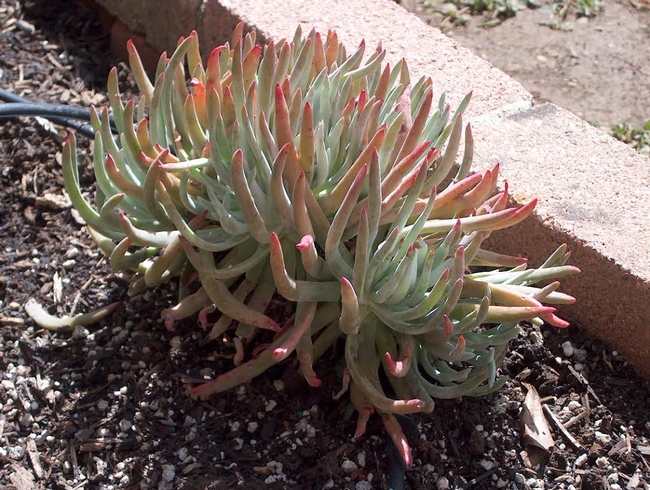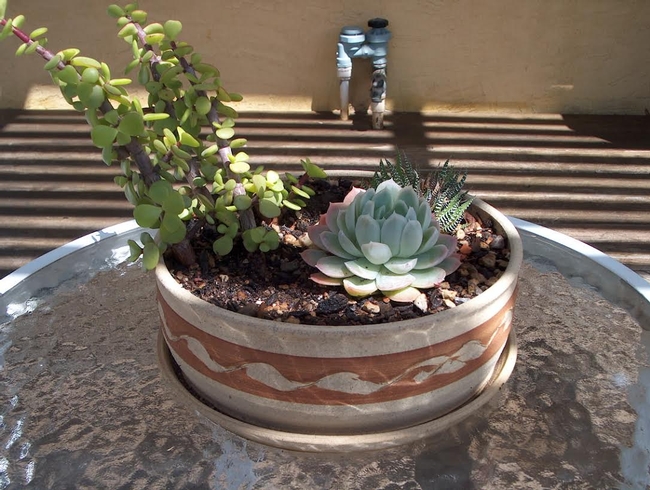
What is the difference between cacti and succulents? All cacti are succulents but not all succulents are cacti. Named for the Latin succulentus, meaning juice or sap, succulents are defined by their liquid storage ability and belong to many different botanical families.
The cactus plant is defined by small, spherical, pillow-like structures called areoles from which spines, branches, leaves, hairs and even flowers emerge. Many succulents look similar to cactus, but if they do not have these cushiony areoles, then they are not in the cactus family (Cactaceae).
Succulents are native to most parts of the world whereas cacti occur naturally only from Alaska to Chile. In Maine, Vermont and New Hampshire, a native cactus has never been found. Surprisingly, Canada boasts several native cacti that have evolved to survive the harsh winters.
In Napa Valley's Mediterranean climate, succulents are a good choice for an easily maintained, slower-paced garden. Most require little water. However, low care does not mean no care.
Check your succulents regularly to catch and treat stressed plants quickly. An actively growing succulent may need water anywhere from once a week to once a month depending on the type and size of the plant, its location, the container and the weather.
The larger the plant and the plumper and fatter the leaves, the less water the plant needs. Keep the soil as moist as a wrung-out sponge. Use a drip system or water by hand, but moisten the soil and not the plant. Water can cause “sunburn” spots on the leaves.
If you forget to water, succulents usually adjust; if you over water, no worries. Unless waterlogged, they do fine. When in doubt, don't water.
Although they do not do well in full shade, succulents need only three to four hours of sunlight daily. Protect them from the onslaught of the midday sun. Early-morning and late-afternoon sun is best, with filtered exposure at noon. The plants need much less sun in winter, but be sure to protect them from frost. The succulent's plump leaves freeze easily.
With their shallow root systems, succulents do well in pots or in the ground. Nurseries sell container mixes for cactus, but you can make your own with two parts potting soil to one part perlite and one part coarse sand. Remove the plant from its nursery pot and spread the roots out on top of a small mound of soil. Add more soil but keep the roots shallow; press down softly to anchor the plant.
At the time of planting, add one teaspoon of slow-release fertilizer per gallon of soil. In spring, feed plants with a low-nitrogen liquid fertilizer diluted to half strength; be sure to moisten the soil first. Do not over-fertilize or the plant may develop softened foliage that is susceptible to rot.
Like all plants, succulents need occasional dividing, deadheading and pruning. They experience a growth spurt when moved to a larger pot. Some succulents are winter growers and look unwell in summer. Resist the impulse to overwater them during this period.
For most succulents, early summer is a good time to propagate. Allow new cuttings to dry or “callus” before planting them. Putting them in soil immediately encourages the cuttings to draw too much moisture and possibly rot.
Succulents are not plagued by many pests. Aphids, spider mites and mealy bugs are the most common. A judicious squirt of water from a spray bottle or hose removes these invaders easily. A cotton swab soaked in isopropyl alcohol and dabbed directly on the pest will also work. Avoid getting alcohol on the plant as it might damage the leaves. For more information on dealing with the pests that plague succulents, visitwww.ipm.ucdavis.edu.
Recently I attended a local flower show, and all the amazing ideas for using succulents really got my creative juices flowing. One display was of miniature fairy gardens complete with rock paths and little houses. My mind immediately started creating a tiny landscape of chubby, scalloped, speckled, spikey, fleshy, prickled succulents. The possibilities are endless and only limited by my imagination.
Workshops: U. C. Master Gardeners of Napa County will conduct a workshop on “Succulent Gifts” on Sunday, November 8, from 2 p.m. to 4 p.m., at the Yountville Community Center, 6516 Washington Street, Yountville. Bring your own love of succulents to this workshop dedicated to making gifts for the holidays or for yourself. Master Gardeners will concentrate on the right kind of soil and care for succulents, discuss the myriad succulent types, and help you make a succulent garden or two to give as gifts. Please bring succulent cuttings if you would like to share. Call 707-944-8712 to register or visit the Parks and Recreation web site.
“Succulent Gifts” workshop will be repeated on Saturday, November 14, from 9:30 a.m. to 11:30 a.m. at the University of California Cooperative Extension Office, 1710 Soscol Avenue, Napa.
Online registration (credit card only)Mail-in registration (cash or check only)
Master Gardeners are volunteers who help the University of California reach the gardening public with home gardening information. U. C. Master Gardeners of Napa County ( http://ucanr.org/ucmgnapa/) are available to answer gardening questions in person or by phone, Monday, Wednesday and Friday, 9 a.m. to Noon, at the U. C. Cooperative Extension office, 1710 Soscol Avenue, Suite 4, Napa, 707-253-4143, or from outside City of Napa toll-free at 877-279-3065. Or e-mail your garden questions by following the guidelines on our web site. Click on Napa, then on Have Garden Questions? Find us on Facebook under UC Master Gardeners of Napa County.
Attached Images:
